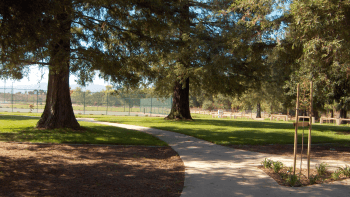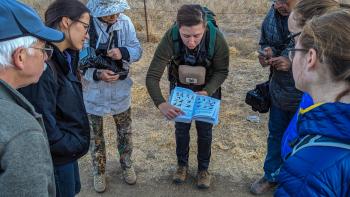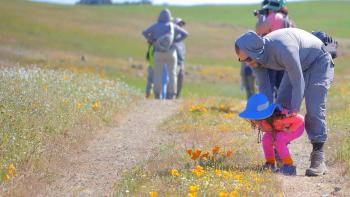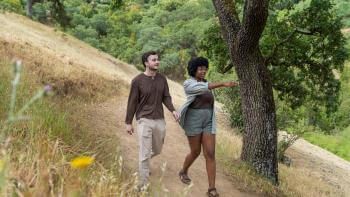Feathered Travelers: A Fall & Winter Guide to Santa Clara Valley’s Migratory Birds
Did you know there are some birds that you can only see in Santa Clara Valley during the fall and winter? Thanks to the Pacific Flyway, a flight path for migratory birds that passes through California, we get the chance to see a rich variety of bird species that live elsewhere during other times of the year.
Meet seven of our region’s migratory birds, who escape the chilly North to spend the cold seasons in balmy California.
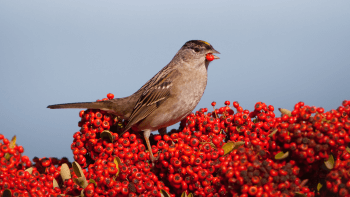
Golden-crowned Sparrow
This large songbird is a common winter resident across the Bay Area. It is identifiable by a plain tan-gray body with distinct black and golden-colored stripes on the top of its head.
They have a slow, mournful song of three to four descending whistled notes. According to the Cornell Lab of Ornithology, “Gold-rush miners took cold comfort from this bird’s melancholy song, which seems to reflect the bleak beauty of its surroundings.”
You can spot golden-crowned sparrows across the Santa Clara Valley, from forest edges and chaparral to urban parks and backyards. Look for them from September through April.
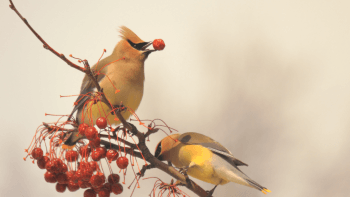
Cedar Waxwing
These winter residents can be found in our region’s parks, backyards, orchards and foothills. Cedar waxwings eat primarily fruits and berries — look for them on and around native plants like toyon, ceanothus, elderberry and twinberry honeysuckle. It is one of the few North American birds that specializes in eating fruit!
Our friends at Santa Clara Valley Bird Alliance describe the cedar waxwing as having a “Lone Ranger mask, lemon-yellow tail stripe and jeweled red “wax” wingtips.”
Their call is best described as “a continuous high-pitched wheezing sound that floats in the air.”
Cedar waxwings arrive in California in fall and winter and stay until late February or early March when they fly north to breed in the northern United States and Canada.
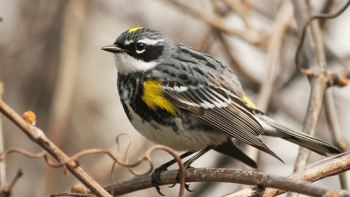
Yellow-rumped Warbler
Yellow-rumped warblers are medium-sized songbirds with big heads and beautiful gray, white and yellow plumage. Like the cedar waxwing, adult yellow-rumped warblers have black “bandit masks” over their eyes.
These birds often travel in flocks during the winter—if you see one, there are likely several more around! They eat insects as well as berries.
Look for them in open woods, shrublands, parks or even neighborhood backyards!
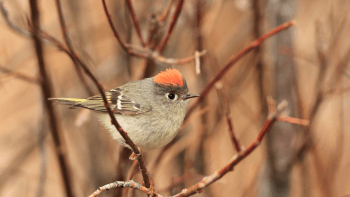
Ruby-crowned Kinglet
This tiny songbird has an olive-green body with black and white bars on its wings. Males have bright red (ruby!) crowns—although these red crests are only displayed when the bird is excited or agitated.
The ruby-crowned kinglet’s song is best described as loud and excited chattering.
Ruby-crowned kinglets arrive in the Santa Clara Valley in early fall and leaves in early spring to breed in the north. Between September and April, look for these birds in woodlands, shrubby habitats, parks and yards.
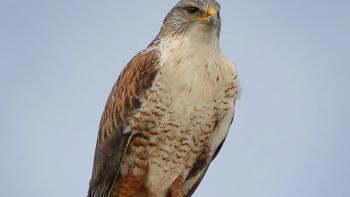
Ferruginous Hawk
These large hawks are most commonly light colored, with striking white and rusty-colored feathers (ferruginous hawks can also be dark colored, but they are rarer). Males and females have similar plumage, but females are generally slightly larger.
Ferruginous hawks prefer wide open habitats, like grasslands, prairies and scrubland. Look for these hawks at Sierra Vista and Coyote Valley open space preserves throughout the winter!
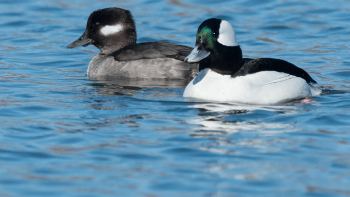
Bufflehead Duck
From its silly name to beautiful iridescent head, we love this winter visitor! Buffleheads are small diving ducks. Males are black and white with dark, iridescent heads and large white head patches; females are gray-brown with white cheek patches.
In the winter, buffleheads migrate from Canada and Alaska, south along the Pacific Flyway to congregate along the coasts. You can find them in bodies of water across the Bay Area during the winter – including lakes, ponds, estuaries and shallow saltwater bays.
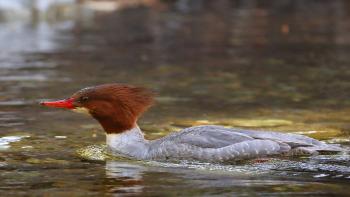
Common Merganser
Another winter waterfowl, the common merganser is a large duck with a long body and narrow bill. Males and females look quite different: while males have bright white bodies and smooth, iridescent green heads (like a mallard’s), females have gray and white bodies with shaggy, rust-colored heads.
They are mostly silent birds, but you may hear a high “cro cro cro” call from females to call their ducklings.
Between November and March, keep an eye out for these striking ducks in Santa Clara Valley’s lakes, ponds and wetland areas.
As biodiversity continues to decrease due to climate change and habitat loss, helping native and migratory birds survive and thrive is one of many reasons the Open Space Authority dedicates efforts to protecting and restoring habitat in the Santa Clara Valley. This work supports many other species, including people!
Learn more about our work.
Want to see these birds in person?
Sign up for our monthly News & Events email to get the first look at FREE upcoming nature programs, including birdwatching!
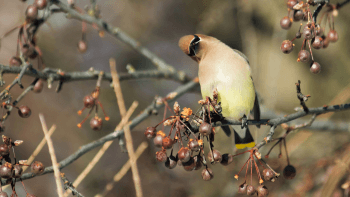
Looking for more like this?
Check out A Birdwatcher's Guide to Coyote Valley and Nature Photography 101.
